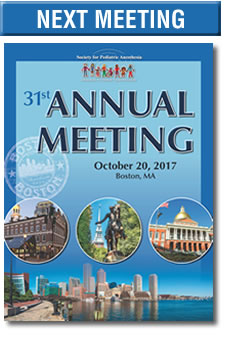spa-aap reviews
CRNA/Allied Health Symposium
Reviewed by Kimberly A. Russo, CRNA
Nemours, A I DuPont Hospital for Children
Sunday morning at SPA, the CRNA/Allied Health symposium was held, moderated by Sarah Laqua CRNA (Texas Children’s Hospital). Six dynamic speakers shared their expertise and passion for their subject with us.
B. Randall Brenn, MD (Nemours, A I DuPont Hospital for Children) started us off with his presentation on practical data mining: turning data into knowledge. Dr. Brenn discussed data driven health care specifically related to the improvement of anesthesia quality and safety. We are inundated with data and Dr. Brenn explained how it can be used to manage processes, answer questions, and solve problems. Dr. Brenn also discussed the importance of integrated data systems. Some specific data he presented revolved around how accurate documentation effects billing. Additionally, Dr. Brenn presented data related to antibiotic delivery and compliance with documentation guidelines. After putting into place a system of reminders and data collection, evidence showed a drop in infection rates. Another major project he discussed was a pain management team’s approach to pain control in the sickle cell population. After implementing a care set, data showed decreases in hospital length of stay as well as reduced admissions. Dr. Brenn concluded that data can be turned into knowledge and used to benefit patients and staff.
Judy Audus, CRNA (Cincinnati Children’s Hospital) spoke on anesthetic management of patients undergoing selective internal radiation therapy (SIRT) for treatment of pediatric liver tumors. While this treatment has been used extensively with adults it is quite groundbreaking with children. Thus far, Cincinnati Children’s has performed SIRT on eight patients, mostly for palliative care. Ms. Audus described the basics of ionizing radiation and reviewed current treatment. She described protective principles and stressed safety to self and patient regarding the lowest reasonable allowance of exposure. Ms. Audus discussed the use of dosages that had limited effect on surrounding tissue. She described the meticulous handling of the isotope and the involvement of nuclear medicine with radiation safety. SIRT in these cases, is specifically transarterial radioembolization with YTTRIUM-90 or TARE Y-90. Initially, the child undergoes mapping arteriography via the hepatic artery. Next, the isotope is delivered to the liver tumor. This advanced care will likely prove very helpful in the pediatric liver tumor population.
Margaret H. Hartig, CRNA (Lurie Children’s Hospital of Chicago) approached the ethical dilemma of the do not attempt resuscitation (DNAR) status in the pediatric palliative surgical population. She described the increase in the palliative care population undergoing procedures and the unique problem a DNAR status presents in the operating room and other anesthetizing locations. Goals noted for end of life would be avoiding or relieving suffering in order to have the highest quality of life possible under the circumstances. Ms. Hartig discussed the importance of “having the conversation” and not being rigid on rescinding DNAR during anesthesia. The procedures are often used to relieve symptoms such as drains or access lines. Parents would consent to the extension of intervention. She stressed some age specific concerns, specifically possible assent on 7-14 year olds and likely assent in patients 14 and older. While it can become emotionally draining to care for the DNAR end of life patient we need to be mindful of patient autonomy and respect individual wishes.
Rhonda Martone, CRNA (Texas Children’s Hospital) shared her expertise surrounding the frequently challenging cardiac cath lab. Ms. Martone provided an overview and high points encountered with congenital heart disease (CHD) in the cardiac cath lab. While there have certainly been advances in the treatment of CHD, challenges occur with more complex, sicker, inoperable patients along with caring for adults with CHD in a pediatric facility. She covered commonly performed procedures and their care. Additionally, she described specifics about interpretation of physiologic and angiographic data. Ms. Martone stressed the importance of a comprehensive history and physical along with pre- operative optimization. She covered shunting issues and ventilation perfusion mismatch. She talked about the use of nitric oxide in pulmonary hypertension along with specific drugs to consider with hypoxia. Ms. Martone dispensed a lot of information that could prove very helpful for those caring for patients with CHD.
Barbara DeZayas, CRNA (Children’s Hospital of Philadelphia) explained to the group the value and impact that a dedicated idiopathic spine fusion team has had on patient care, cost savings, staff satisfaction, and overall quality improvement at her hospital. Ms. DeZayas worked along with orthopedics, nursing, and others to create this team. It was interesting how in the development stages they used a NASCAR analogy. Everyone has a job they have done 1000 times and each completes their task efficiently. They created a positive team environment, mutual respect, and effective communication. Patients being cared for by the dedicated team left PACU sooner and length of stay was decreased. The team encountered some barriers but demonstrated a process change that improved quality, provided cost savings, and contributed to staff satisfaction. Dedicated teams for specialty surgery is something to consider if evidence points to improved quality and costs savings.
Last at the podium was Doyle Lim, MD (Nemours, A I DuPont Hospital for Children) speaking on the tenets of ultrasound (US) use in pediatric regional anesthesia and vascular access. Dr. Lim told of the efficacy and safety of US use. Ultrasound is ideal because of low cost, no radiation, and real time imagery. Most recently a portable iPad size ultrasound has become available that could eliminate a bulky US machine. A must is to know where your needle tip is at all times. He stressed this so one would have decreased entry into undesired tissue. Dr. Lim acknowledged some hurdles specifically in the learning curve of trainees and time costs during training. In his practice, use of US for vascular access has caused fewer attempts and taken less time. As far as US for regional anesthesia Dr. Lim discussed US versus landmark stimulation. He uses stim needle along with US for his regional blocks. Some tricks he passed on were to use a thin amount of gel, rocking the probe can help, and to keep your eyes on the screen. Clearly, ultrasound guided regional anesthesia and vascular access will become more and more commonplace and it behooves us all to practice in the simulation lab or attend a course and become proficient with this excellent device.






